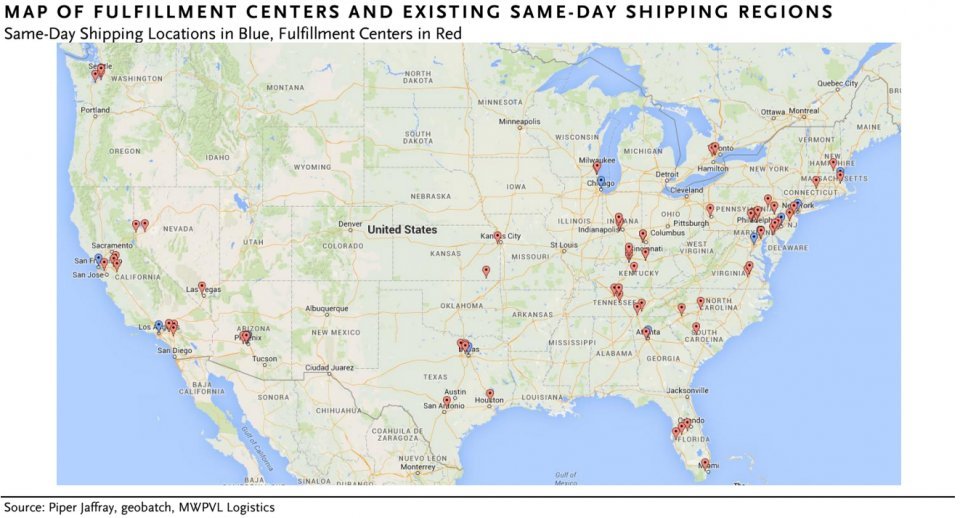The last 24 hours is the reason why Amazon has hired Jay Carney, a former Obama spokesperson to be responsible for global corporate affairs. Amazon has seen a fair share of controversy over the warehouse workers and working conditions. As usual the company has largely remained quiet and I believe this is one of the areas in which Carney will be more verbal.
The issue is in my mind – the technology chameleon that does ecommerce (Amazon) is still very reliant on human intervention when packing of purchases are done inside Amazon warehouses. Speed and efficiency which is sold to customers lead to very harsh working conditions for seasonal and temporary workers. Robots who don’t have unions can only work for so many hours until they need recharging. Also sometimes logic is needed for packing which cannot be seen inside a robot.
Warehouses are pressure points globally
These issues are not solely seen in the US, in Germany Amazon has seen a fair amount of strikes as well.
In middle December, a week before one of Amazon’s most important days (Christmas) workers used the opportunity to strike.
More than 2,000 Amazon staff at German warehouses went on strike on Monday to press demands for better pay and conditions as the online retailer races to ensure Christmas orders are delivered on time.
Labor union Verdi said almost 2,300 workers joined the action at five of Amazon’s nine distribution centers in Germany, and that the action would be extended to a sixth on Tuesday – the most warehouses hit by a strike in the long-running dispute.
It was not only seen in Germany, French Amazon warehouse workers also used the opportunity for force Amazon’s hand:
Boisonnet says that the strike is not to upset customers or to block the trucks delivering Christmas parcels, but for Amazon to pay attention to worker claims.
CGT is calling on Amazon to open negotiations on work conditions and salaries.
40% of Amazon’s staff are members of the CGT union, the first union to organize workers in the company. But there are fewer card-carrying union members in Northern France.
Late in 2014 warehouse workers made a Supreme Court case against Amazon in order for the company to pay them for the time spent while they are being searched entering or leaving a warehouse.
The Supreme Court just handed a big holiday present to low-wage workers across America in the form of a giant f*ck you. It’s a reminder that while on some cases the court—like politics in general—may seem divided by red and blue, when it comes to decisions that affect big business in America, it’s all about the green. Forget the bullpucky about the “War on Christmas.” There’s a real “War on the Working Class” under way, and the Supreme Court just made it worse. So much for happy holidays.
At Integrity Staffing Solutions in Nevada, a subcontracted company where workers process and ship Amazon goods, employees have to undergo screenings at the end of the day, every day, apparently to ensure they aren’t stealing things. Because, you know, we can trust Wall Street not to steal from their clients let alone defraud our entire economy—AIG, Bernie Madoff, must I go on?—but we can’t trust low-wage workers not to steal small electronics. That seems fair. Anyway, workers at the Integrity Staffing Solutions facilities are paid by the hour and say these security checks often take up to a half hour every day. (The Daily Beast, December 2014)
This is not new behaviour
Also because when you’re late or sick you miss the opportunity to maximize your overtime pay. And working more than eight hours is mandatory. Stretching is also mandatory, since you will either be standing still at a conveyor line for most of your minimum 10-hour shift or walking on concrete or metal stairs. And be careful, because you could seriously hurt yourself. And watch out, because some of your coworkers will be the kind of monsters who will file false workers’ comp claims. If you know of someone doing this and you tell on him and he gets convicted, you will be rewarded with $500. (Mother Jones, February 2012).
If one looks at Amazon’s offline direct competitor Walmart this scenario is also seen and has lead to multiple court cases. As much as technology is used in these behemoth businesses, humans are still a very large part of their success.
Wait 18 months for employment
Yesterday, The Verge broke a story that made me shake my head in complete disbelief. Amazon, a company I deeply respect requires temporary warehouse workers to sign non-compete clauses which does not allow the employees to work at similar businesses for 18 months post termination at Amazon. Yes, you read right and these are not rocket scientists, Vice Presidents or Company Founders but temporary warehouse workers.
“The work is repetitive and physically demanding and can pay several dollars above minimum wage, yet Amazon is requiring these workers — even seasonal ones — to sign strict and far-reaching non compete agreements. The Amazon contract, obtained by The Verge, requires employees to promise that they will not work at any company where they “directly or indirectly” support any good or service that competes with those they helped support at Amazon, for a year and a half after their brief stints at Amazon end. Of course, the company’s warehouses are the beating heart of Amazon’s online shopping empire, the extraordinary breadth of which has earned it the title of “the Everything Store,” so Amazon appears to be requiring temp workers to foreswear a sizable portion of the global economy in exchange for a several-months-long hourly warehouse gig.” The Verge, March 2015
Why would Amazon require these blanket agreements?
Firstly, over the last 18 months Amazon have been spending billions of dollars into logistics. They have been gradually taking more control of the last mile in terms of delivery by means of sorting centers. This does not come cheap and needs a lot of capital and human capital.
Secondly Amazon has been accelerating their roll out Prime Now locations and fulfillment centres. In many cases like this you have a large amount of people who have a fair amount of intellectual property in their heads through daily operations. This does not mean that temporary warehouse workers should be given non-compete contracts.
The above image clearly indicates the size and scope of Amazon’s investment into logistics in the US.
In case you can’t tell, Amazon currently offers same-day shipping in New York City, Atlanta, Baltimore, Boston, Chicago, Indianapolis, Philadelphia, Washington D.C., Dallas, Los Angeles, Phoenix, San Francisco, and Seattle. The map hints that Florida, Tennessee, and Virginia could each make good same-day delivery expansion targets.
Right now, Piper Jaffray analysts estimate that the locations of Amazon’s fulfillment centers bring it within 20 miles of 31% of population, but within 20 miles of 50-65% of its core same-day addressable market (Jaffray came to this higher percentage by predicting that only households with an annual income of $50,000 would be interested in same-day delivery). Business Insider, March 2015
I see this non-compete contract enforcement as a sign that Amazon is treating there logistics investment as a defensible. The temporary warehouse staff is an asset that could on departure put Amazon into a place which would make them a target for their competitor.
I also believe that Amazon is indirectly concerned over the on demand delivery startups such as Instacart, Shyp and others whom would be providing services to Amazon competitors with contractors instead of staff. The fact that these on demand startups are highly dependent on contractors to do the fulfillment highlights the fact that human workforces are the most prized asset for ecommerce fulfillment.
After The Verge broke this story Amazon has started the process to remove this clause from hourly associates contracts.
Amazon is to remove a “non-compete” clause from its employment contracts for US workers paid by the hour after criticism that it is unreasonable to prevent such employees from finding other work.
A company spokeswoman confirmed to the Guardian that the clause would be cut.
“That clause hasn’t been applied to hourly associates, and we’re removing it,” she said. The Guardian, March 2015
Notice that the news was reported by The Guardian, instead of The Verge, a sign that this topic was not going to be resolved by replying back to the origin of the story. The questions which is raised for me is, If The Verge did not break this exclusive story would Amazon have removed this clause from hourly associates contracts?
A long term solution
Amazon seems to be indicating that warehouse automation and usage of robotics will be the long term solution. Amazon bought Kiva Systems in March 2012 partly to automate some of their own warehouses after acquiring the Quidsi business.
In May 2015 Amazon has a picking challenge for universities and other interested parties.
Automated item picking is an important skill for many robot applications including warehousing, manufacturing, and service robotics. Generalized picking in cluttered environments requires the successful integration of many challenging subtasks, such as; object recognition, pose recognition, grasp planning, compliant manipulation, motion planning, task planning, task execution, and error detection and recovery.
In an automated Amazon warehouse, thousands of mobile robots move 1-meter square shelving units from storage locations to picking stations and then back to storage. Associates stand in the stations and pick items off the shelves and put them into boxes that are shipped to customers. A typical bin on a shelf will have up to 10 items in it–often packed tightly together–and the associate is able to identify the right product, pick it out of the bin, scan the barcode for verification, and put the item in a box, all in only a few seconds. A typical Amazon warehouse holds several million different products. While many of these items are regularly shaped, like books and DVDs, there are also teddy bears, children’s necklaces, vacuum-packed USB sticks, and thousands and thousands of other shapes, sizes, and materials.
The first Amazon Picking Challenge poses a simplified version of the picking task. Contestants’ robots will be placed in front of a stationary Kiva shelf. The contest shelf will be relatively lightly populated, with many of the bins holding only a single item, and a few holding multiple copies of the same item. A few bins may hold multiple different items. The products will range in shape and size. Some will be solid cuboids, but some will be items that are pliable and/or harder to grasp.
Robots are the logical long term solution for any ecommerce business that does it’s own fulfillment. Would this not be better solved with a pay raise for the temporary warehouse workers that work alongside the robots?

